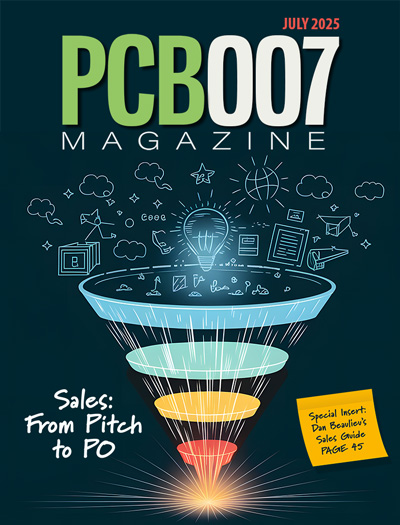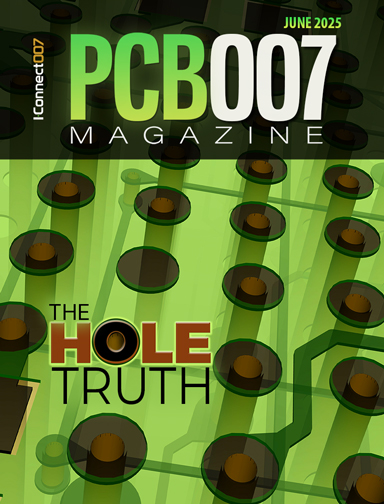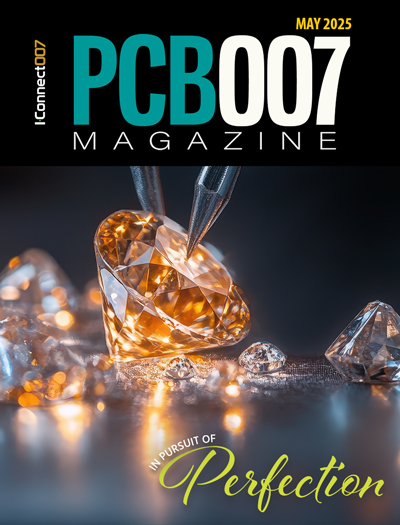-

- News
- Books
Featured Books
- pcb007 Magazine
Latest Issues
Current Issue
Sales: From Pitch to PO
From the first cold call to finally receiving that first purchase order, the July PCB007 Magazine breaks down some critical parts of the sales stack. To up your sales game, read on!

The Hole Truth: Via Integrity in an HDI World
From the drilled hole to registration across multiple sequential lamination cycles, to the quality of your copper plating, via reliability in an HDI world is becoming an ever-greater challenge. This month we look at “The Hole Truth,” from creating the “perfect” via to how you can assure via quality and reliability, the first time, every time.

In Pursuit of Perfection: Defect Reduction
For bare PCB board fabrication, defect reduction is a critical aspect of a company's bottom line profitability. In this issue, we examine how imaging, etching, and plating processes can provide information and insight into reducing defects and increasing yields.
- Articles
- Columns
- Links
- Media kit
||| MENU - pcb007 Magazine
Rex Rozario: The PCB Industry’s True Renaissance Man
March 14, 2016 | Barry Matties, I-Connect007Estimated reading time: 9 minutes
You may know Rex Rozario OBE, as a part of the team that developed the first circuit board in England in the 1950s, or for being the founder of Graphic PLC, which has been serving the industry for 50 years and achieved phenomenal, long-term success in China. What you might not know about are the many other lives of Rex: the successful restaurateur, the developer and co-owner of a marina voted best in the UK, and the drummer in a band called The Flintstones. As a matter of fact, in one of his past lives, Rex took drum lessons from Jim Marshall, of Marshall Amplifier fame. If you can’t tell already, Rex is cool.
In this exclusive I-Connect007 multi-part interview that was conducted recently, I will introduce you to all of the people that Rex Rozario is, and where he, his team, and Graphic PLC are headed to next.
Barry Matties: Rex you’ve been working with circuit boards for a long time. Please begin by explaining how you began in the PCB industry.
Rex Rozario: When I left Ceylon, which is now Sri Lanka, I went to England to finish my studies at two technical colleges, Reading and Acton, before graduating at Brunel with an electrical and electronics degree. While at university, I did odd jobs to keep the cash coming in and I got involved doing some work for a condenser company; I learned quite a bit about condensers. After I graduated, I found a very large condenser manufacturer not far from the university, called the Telegraph Condenser Company, and it employed about 3,000 people.
I applied and was offered a job as a lab technician because of my experience working part time on condensers. When I joined I had already paid for a vacation and they honored that. But when I returned, a guy was doing my job. He said that he had started the day I had left or whatever. So I assumed that because I was on vacation and I hadn't been there long enough that possibly I was fired and caught the bullet.
Then the manager wanted to see me. He said, “I'm glad you're here, come with me.” I asked where we were going and he said, "To the managing director’s office." Of course, this company employed 3,000 people and nobody ever saw the managing director. Nobody even knew what he looked like. I didn’t know what to expect. I walked into his office and there were six other guys sitting at the table. He started talking and said he had a new venture in mind and they had just acquired the license to manufacture. Here of course is where printed circuits came into the picture.
Then he had a phone call, and back then you didn't have mobile phones, so he had to dash off to the next office. I turned and asked the others, "What is he talking about?" They hadn't a clue. They said, "He keeps talking about printed circuits." He came back and said he was forming a team and we were part of this team. He introduced each person. They were all skilled. One guy, the most important guy, was a silkscreen specialist, another was a chemist, a mechanical engineer, photographer, etc. Those were the key people, and I was coming in now as a technician with my electronics degree.
Then we were given a shed across the road by rail lines, about 1,000 square feet I’d say, and that's it. We said, "Where do we start?" He said, "You don't have to worry." The license was bought from Dr. Paul Eisler who formed a company called Technograph. We were Telegraph, and we acquired the first license to manufacture, and he was brought in as a consultant. It was like the blind leading the blind. We didn't know where to start or where to get the materials from. Everything was done by trial and error and development. The first material was wallpaper material. We had to use this material, which was paper based, impregnate it with resin, buy the copper sheets and actually brush the adhesive onto that, stick it on, and then of course put it into a press. So from day one we had experience of how to use a heated platen press, and that's how multilayer technology came in, from day one. And then we had to print and etch.
Paul Eisler’s innovation wasn't very high tech. He used the graphic arts litho plate-making technology that used the same sort of printing as silkscreen or photo printing solutions. So that's how we started, with single-sided boards, and it was pretty straightforward.
(See historical video, next page.)
Page 1 of 2
Testimonial
"We’re proud to call I-Connect007 a trusted partner. Their innovative approach and industry insight made our podcast collaboration a success by connecting us with the right audience and delivering real results."
Julia McCaffrey - NCAB GroupSuggested Items
Designers Notebook: Basic PCB Planning Criteria—Establishing Design Constraints
07/22/2025 | Vern Solberg -- Column: Designer's NotebookPrinted circuit board development flows more smoothly when all critical issues are predefined and understood from the start. As a basic planning strategy, the designer must first consider the product performance criteria, then determine the specific industry standards or specifications that the product must meet. Planning also includes a review of all significant issues that may affect the product’s manufacture, performance, reliability, overall quality, and safety.
I-Connect007 Editor’s Choice: Five Must-Reads for the Week
07/18/2025 | Nolan Johnson, I-Connect007It may be the middle of the summer, but the news doesn’t quit, and there’s plenty to talk about this week, whether you’re talking technical or on a global scale. When I have to choose six items instead of my regular five, you know it’s good. I start by highlighting my interview with Martyn Gaudion on his latest book, share some concerning tariff news, follow that up with some promising (and not-so-promising) investments, and feature a paper from last January’s inaugural Pan-European Design Conference.
Elephantech Launches World’s Smallest-Class Copper Nanofiller
07/17/2025 | ElephantechJapanese deep-tech startup Elephantech has launched its cutting-edge 15 nm class copper nanofiller – the smallest class available globally. This breakthrough makes Elephantech one of the first companies in the world to provide such advanced material for commercial use.
Copper Price Surge Raises Alarms for Electronics
07/15/2025 | Global Electronics Association Advocacy and Government Relations TeamThe copper market is experiencing major turbulence in the wake of U.S. President Donald Trump’s announcement of a 50% tariff on imported copper effective Aug. 1. Recent news reports, including from the New York Times, sent U.S. copper futures soaring to record highs, climbing nearly 13% in a single day as manufacturers braced for supply shocks and surging costs.
I-Connect007 Editor’s Choice: Five Must-Reads for the Week
07/11/2025 | Andy Shaughnessy, Design007 MagazineThis week, we have quite a variety of news items and articles for you. News continues to stream out of Washington, D.C., with tariffs rearing their controversial head again. Because these tariffs are targeted at overseas copper manufacturers, this news has a direct effect on our industry.I-Connect007 Editor’s Choice: Five Must-Reads for the Week


